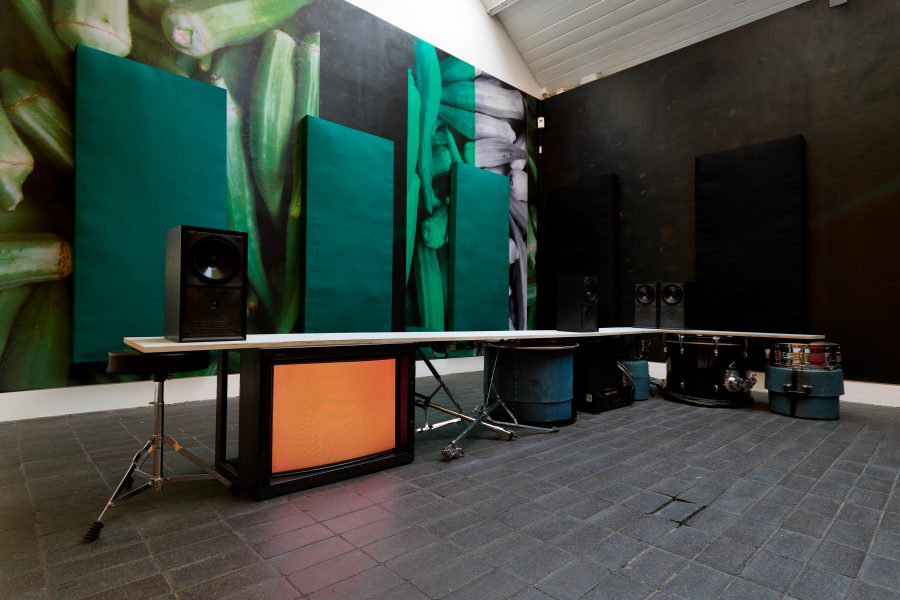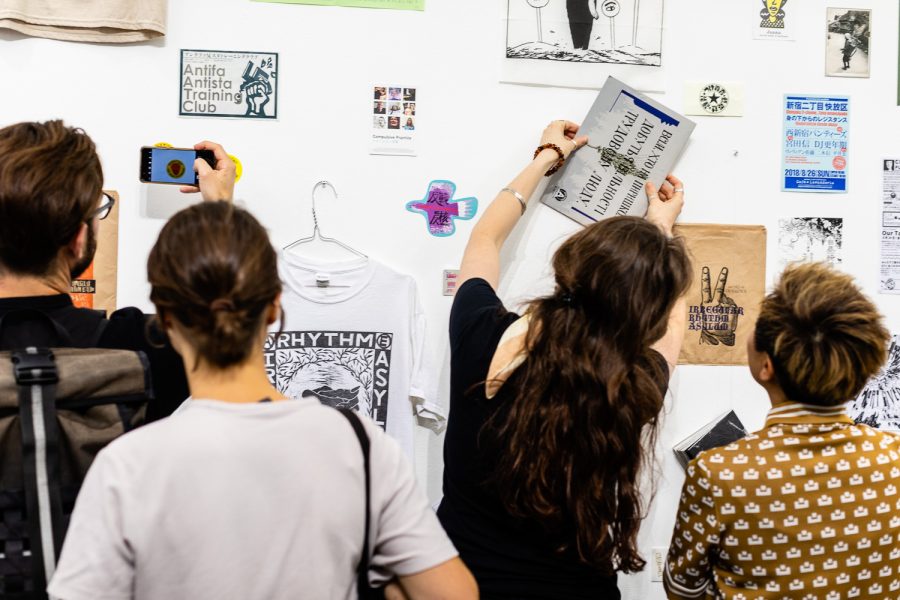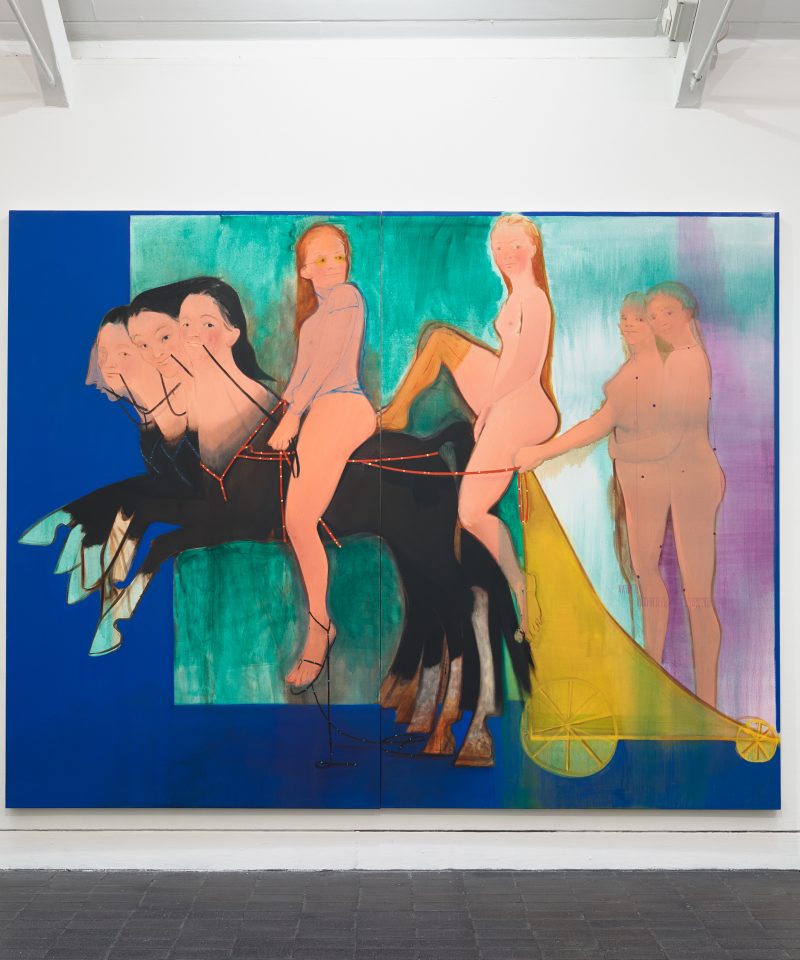It didn’t so much begin as sputtered into life mid-beat: the hi-hat teased gathering momentum then stopped. The crash cymbals hashed away, while the snare drum rollicked into life. After a few minutes, new sounds cut through the reverberations. A bass drum called the other cymbals to order, coalescing the beat into a rhythmic almost danceable cadence. Some people’s heads nodded along to the beat momentarily. Others hesitantly attempted a tapping foot. And then the rhythmical sequence would change. Although we couldn’t see him, we knew the drummer was in full compelling focus lost in his own timbre, inflections and time. Our presence brought with it our own idiosyncratic rhythms, time and expectations. During: Baste on Narration was a performance by Appau Junior Boakye-Yiadom featuring drumming by Hector Plimmer for Jerwood Solo Presentations 2019.
I use the word performance tentatively. In many ways it was a refusal of that very categorisation. In this instance, a musician played a drum-kit that was previously dismantled in the gallery, inhabiting a space of both function and installation. We could hear the drummer but we couldn’t see him as he was hidden behind a wall. Instead, we saw close-up, abstracted fragments of the drum-kit being played through a live feed on a TV monitor in front of the wall on the ground. A mediated and once-removed experience of the ‘live performance’ we normally expect to unfold directly in-front of us. At first it was hard to situate yourself in the space. When the screen was blank, which happened frequently while the angle changed, there was nowhere to look other than at the residue of the remaining installation and the other people listening. As an artist, Boakye-Yiadom resists singular narrative by layering his installations with disparate references. The sense of fragmentation is acute.
Boakye-Yiadom’s work is interested in the universal nature of drumming. Every culture has its own version of drum that is used in several different ways.[1] As an assemblage, “the drums” or drum-kit is a relatively young instrument, made up of several components, originating over a century ago in the port city of New Orleans. The snare and bass drum derived from the Military bands after the Spanish-American war ended in 1898. When the troops returned from Cuba, many re-entered the United States through New Orleans, bringing an influx of marching band instruments, which in turn were passed on to locals in pawn shops. Chinese immigrants brought with them woodblocks, temple blocks, gongs, and tacked “tom toms” while cymbals emerged from bronze cisterns that were eventually hammered into flatter discs. These are made by a Turkish family named Zildjian who have become a household name in the music industry.[2]
There is no consensus over who exactly was the first drummer to play a drum-kit. Edward “Dee Dee” Chandler is said to be the musician who originally put the snare and bass drum together with a crudely designed pedal.[3] Prior to the twentieth century, multiple percussionists would share the stage playing a single drum each, rather than one musician commanding an entire set. In order to free up space on stage and cut costs, band directors paid one drummer who could then play the bass drum with his foot and the snare with his hands and with that, the other appendages such as toms, crash cymbals and hi-hats soon gathered around them.[4] The emergence of the drum-kit is a prime example of what can be achieved in a multicultural environment. Culture is a dynamic thing that doesn’t exist in isolation nor remain static. Boakye-Yiadom’s work uses the drum-kit as a language that investigates cultural production. In this sense, the drum-kit is a site of multiplicity. Appropriately, During: Baste on narration is a series. It evolves and changes with each iteration, constantly mutating. As a sonic sketch for the gallery it is an incomplete gesture that will undoubtedly be re-appropriated in a different live performance to a different audience.
Jazz, in particular, seems to have evolved simultaneously with the drum-kit at its nexus. Historically Jazz[5] comes from places of ‘ill-repute’ such as Storyville, the red-light district of New Orleans as well as minstrel and vaudeville shows that travelled around.[6] Boakye-Yiadom’s work gestures to the illicit beginnings of cultural developments in other parts of the installation, with a two-second video clip from Russ Meyer’s 1976 sexploitation film Up! where the viewer is unzipped and revealed to an ambiguous woman looking down. The monitor showing this is now hidden during the performance, on the other side of the wall. With the live feed of the played drum-kit on the monitor we can see, there is a ‘peeping tom’ element which adds a new layer to the concealed and revealed parts of the installation. This use of technology in a way that it was not originally intended for seems to be central to Boakye-Yiadom’s practice. The contemporary drummer’s domain is usually at the back of the stage, enshrined in a semi-circle of instruments and musicians. The mediation of the performance is alienating enough to bewilder yet still makes you feel part of a live performance process, rather than simply being onlookers at a spectacle. In this sense, it invites the viewer to consider the cultural affect embedded in sound[7] and the possibilities of inhabiting a live audio-visual performance.
The drummer Peter Erskine introduces his technical instruction book Drum Concepts and Techniques very simply with, “The drums are one instrument. Drumset = You.”[8] His advice to budding percussionists is not to approach it as a multi-percussion instrument. Just as your body has many different components that work cohesively in one entity, so should the drums convey one idea. Boakye-Yiadom’s performance piece invites us to think about the “you” part of that equation and who it represents in the development of cultural continuation and dissemination. Today, the multicultural society of London doesn’t appear as cohesive a city as the multicultural society of New Orleans at the turn of the Century when the drum-kit came into being. Boakye-Yiadom seems to suggest the preservation of cultural diversity is something worth striving for, particularly when we bear witness to innovations of multicultural environments such as the drum-kit. This is particularly pertinent in the current political climate.
During: Baste on narration came to an end after two twenty-minute sessions with a beat that sounded like it was dragging itself along, trailing its own dissolution in its wake. The cymbals’ relentless chiming ebbed and flowed while the clatter of the other percussion paraphernalia dwindled. There were some muffled kicks from the bass drum as the reverberating snare that had dominated the soundscape for some time abated with a final bang from the crash cymbal. The hidden performance finished as the TV monitor that had once given us a window into the happenings behind the wall went black one final time.
[1] Boakye-Yiadom stated this in a conversation we had about the work.
[2] For a more thorough reading of the evolution of the drum-kit please see: Shultz, Thomas. A History of Jazz Drumming. Percussive Notes 16, no. 3 (1979): 106-132.
[3] Before the bass drum allowed for this, there was a technique called “double drumming,” wherein one drummer places a bass drum in a chair and plays it with his left hand, while playing a snare with his right.
[4] For more details on “Dee Dee” Chandler, please see Jaina, Nick. The Birth of the Drumset.
[5] Interestingly, Garvin Bushell in his book Jazz from the beginning states, ‘that the French had brought the perfume industry with them to New Orleans and the oil of jasmine was a popular ingredient locally. To add it to a perfume was called “jassing it up.” The strong scent was popular in the red light district, where a working girl might approach a prospective customer and say “Is jass on your mind tonight young fellow?” The term had become synonymous with erotic activity and came to be applied to the music as well.’
[6] Longstreet, Stephen. Storyville to Harlem: fifty years in the jazz scene. Rutgers University Press: 1986
[7] This insight came out of a conversation with Jerwood Arts Gallery Manager Lauren Houlton
[8] Erskine, Peter. Drum Concepts and Techniques. 21st Century Publications, 1987. p.7





